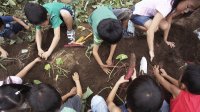Earth Day: Lesson Plans, Reading Lists, and Classroom Ideas
Resources from around the web for incorporating Earth Day into your class.
Earth Day is right around the corner. Many educators are preparing lessons that introduce environmental science concepts for students. Are you planning on incorporating Earth Day into your classroom?
The annual event—which started in 1970—provides students with an opportunity to explore a range of subjects, whether science-based investigations, thematic reading, or creative arts projects. To help teachers brainstorm some ways to incorporate Earth Day into the curriculum, we’ve compiled a list of resources that offer lessons, ideas, tips, and activities that are perfect for Earth Day. There’s a bit of everything, including lesson plans, tools, resources, and student reading lists.
Earth Day Lesson Plans
- American Museum of Natural History Curriculum: The AMNH Curriculum Collections section provides a great starting point for exploring many different natural science subjects. From Antarctica to river ecology, there’s a collection that can be used in almost any classroom.
- Nature Lab: This rich collection of video lesson plans, created by the Nature Conservancy, serves as a great starting point for in-class examinations of ecology. There are science-based lessons with accompanying videos, virtual field trip videos, and Meet the Scientist videos. Plus, with spring nearly here, the site also features some wonderful gardening activities for students of all ages.
- Earth Day Network’s Environmental Curriculum: This EDN-produced environmental education program features interdisciplinary lessons, classroom activities, and tools that will help you and your students explore environmental issues during class.
- The EPA’s Lesson Plans and Teacher Resources: The Environmental Protection Agency’s Earth Day website provides great ideas, lesson plans, and tips for Earth Day learning. Check out the lessons, which cover a range of earth sciences topics, including air, ecosystems, climate change, water, and more. All the featured lessons are available for download, and there are resources for every grade.
- Science NetLinks: Earth Day Lesson Collection: This collection was produced for last year’s Earth Day, but is still relevant this year. Science NetLinks produced a big list of lessons and learning tools on a variety of earth science subjects, and they’re all easy to browse by grade level, subject, and type of project.
Earth Day Activities
- Introduction to Earth Day Activity: Want to help students learn the history of Earth Day? Start here. This activity from the National Geographic Society offers students in grades 3–11 an opportunity to read and discuss Earth Day in the classroom. The organization’s lessons and activities also offer some great ideas for incorporating Earth Day into lessons.
- 22 Interactive Lessons to Bring Earth Day to Life: This roundup of PBS LearningMedia resources is extremely useful for teachers. You’ll also want to check out PBS LearningMedia’s NOVA Earth System Science lesson plans, which are standards-based resources that examine earth sciences. The PBS series Nature is another great teaching tool.
- Resources to Learn About Recycling: The website I Want to Be Recycled is a one-stop shop for students interested in the science of recycling. Produced by nonprofit Keep America Beautiful, the resource features accessible information about recyclable materials, a Recycling 101 course, and information students can use to get involved. A fun place to start: the web-based game Super Sorter.
Earth Day Reading For Students
- Suggested Readings From Project Learning Tree: Looking for a good book to learn about the environment? You’ll find plenty to choose from in this list from Project Learning Tree. Although it was produced in 2014, the books are timeless and informative, and they’re grouped by grade level.
- Earth Day Reading List: Book Culture’s list features great titles for students in grades K–8.
More From Edutopia
- 3 Apps for Teaching Environmental Stewardship by Monica Burns (2016)
- What Can Kids Do for Earth Day (and Beyond)? by Suzie Boss (2016)
- Outdoor Mindfulness Exercises for Earth Day by Patrick Cook Deegan (2015)
- Making Earth Day More Than Just a One-Day Celebration by Suzie Boss (2014)
- Make Earth Day a Global Learning Day by Homa Tavangar (2014)
- Elementary Art and Service Learning Projects for Earth Day and Beyond by Gaetan Pappalardo (2011)
